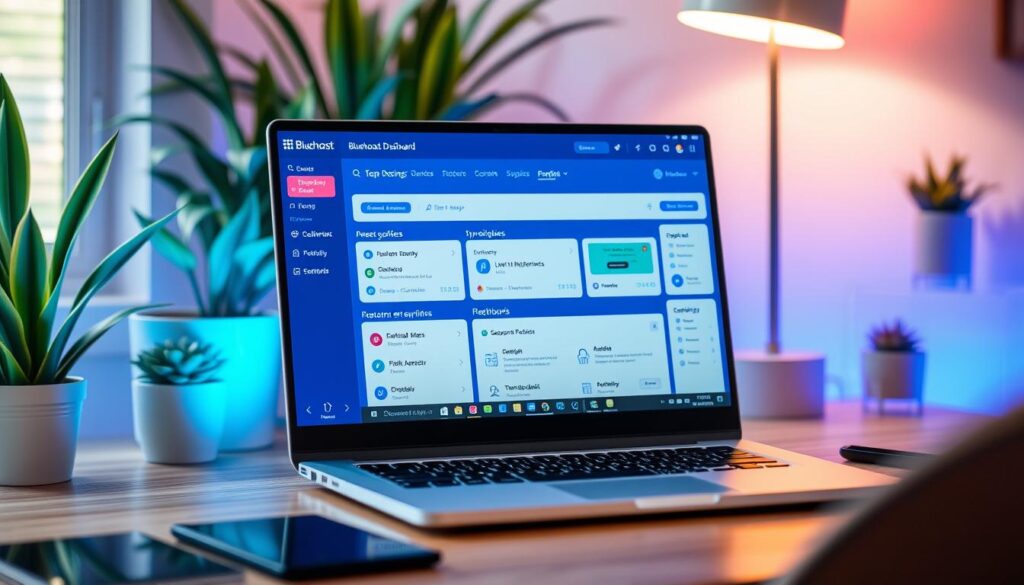Imagine this scene: you’re in your favorite café with your laptop, enjoying the perfect coffee. Today’s the day you start your WordPress blog. As you search for hosts, you find Bluehost, recommended by WordPress.org since 2005. You’re convinced by its user-friendliness and flexibility.
In just 30 minutes, your blog is nearly ready. That’s how quick Bluehost is! They offer a free domain for a year and plans start at $1.99 a month. With Bluehost and a guide to WordPress, you’re set to join the blogging world.
For beginners, setting up a blog on Bluehost with WordPress is easy. The mix of Bluehost’s simple interface and WordPress’s versatility is ideal for new bloggers. This guide helps you from choosing a plan to making your first blog post.
Key Takeaways
- Bluehost has been recommended by WordPress.org since 2005.
- New users can start a blog in just 30 minutes on Bluehost.
- Bluehost offers a free domain name for the first 12 months.
- Hosting packages at Bluehost start at $1.99 per month.
- The guide covers all steps from choosing a plan to publishing your first post.
Why Choose Bluehost for WordPress Blog Hosting
Starting a WordPress blog? Choosing the right host is key. Bluehost stands out for many bloggers. It’s known for great reliability and performance. With a top rating of 4.80 out of 5, Bluehost offers excellent service.
Bluehost is also wallet-friendly. Plans begin at just $2.95 a month. You get free domain names and backups, fitting any budget. The “Basic” plan offers 50GB storage and five email accounts. “Plus” and “Choice Plus” plans give you more – unlimited storage, emails, domains, and subdomains.
Bluehost is very reliable, with an uptime of over 99.96%. Other hosts like DreamHost and InMotion Hosting are close, but Bluehost stands out. It loads pages super fast – in just 1 second. That’s 2.5 times faster than WordPress. Plus, Bluehost’s TTFB (Time to First Byte) beats WordPress, scoring 99 to WordPress’s 77.
Customer support from Bluehost is top-notch. You can reach them 24/7 by phone or live chat. Their support rating is 4.8 out of 5. You get quick help with any issues, perfect for any blogger.
WordPress.org has recommended Bluehost since 2005. It hosts over 2 million websites. With strong credibility, you can pick any package. Whether basic or high-end, Bluehost promises outstanding reliability and performance.
Selecting the Right Bluehost Hosting Plan
Choosing the right Bluehost hosting plan is key to your blog’s success. You might be starting out or planning to grow. Bluehost has various plans to fit your needs. Let’s look into the different bluehost hosting options for your decision.

The Basic Plan Features are great for new bloggers. It’s affordable at $2.95 per month. You get one website, 50 GB SSD storage, unmetered bandwidth, and a free domain for one year. These tools help start your blog strong.
Beginners also get a free SSL certificate. This keeps their site safe.
If you’re ready to grow, consider the Plus Plan Benefits. It starts at $5.45 a month. This plan lets you have unlimited websites, unlimited storage, and unmetered bandwidth. You also get $200 in marketing offers and SpamExperts for email security. It’s designed for bloggers who want to expand.
The Choice Plus Plan Insights give the most options for serious bloggers. Priced the same as Plus, at $5.45 per month. It includes everything in Plus, with privacy and backup adds-ons. Domain Privacy keeps your info hidden for $0.99 a month. CodeGuard Basic keeps your site backed up. This plan suits those who value security and stability most.
Think about these points when choosing:
- Basic Plan Features: Best for blogging starters, offering a simple start.
- Plus Plan Benefits: Good for blogs that are growing, with unlimited options.
- Choice Plus Plan Insights: Best for bloggers who need more security and backup choices.
Starting with Bluehost, you can earn around $5,000 per month in the first year. Successful blogs can make over $20,000 a month. No matter your choice, Bluehost supports your blogging path. Remember, new users save 60% on hosting through special offers.
How to Register a Domain Name with Bluehost
Choosing the Perfect Domain Name with Bluehost is easy and safe. They make it simple to register and manage your domain. Let’s look at how to start this process on Bluehost.
First, log into your Bluehost account. Go to the “Domains” area and click “Register a New Domain.” You can then search for a domain name that fits your blog’s theme.
Bluehost helps you pick a unique domain name. They also make it easy to move an existing domain over. This ensures your domain links up with WordPress without a hitch.
After choosing a domain, you can buy it with Bluehost’s hosting deals. They offer a rate of $2.95 a month. This comes to $106.20 for three years, much cheaper than the usual $287.64.
Domain Privacy Protection from Bluehost is a big plus. It keeps your personal info safe from spam and identity theft. This service is key to keeping your data secure.
To connect your domain to WordPress.com, just update your name servers to ns1.wordpress.com, ns2.wordpress.com, and ns3.wordpress.com. DNS updates usually work in a few hours but can take up to 72. At first, your domain will say “Verifying” then change to “Active” when it’s ready.
Bluehost also provides 24/7 customer support for any setup issues or questions. With over 11 years of hosting experience, Bluehost is a reliable choice for your blog.
- Bluehost registration offers the perfect starting point for your blog
- Enjoy discounted hosting rates and free offers up to $175
- Easy DNS updates for seamless connection with WordPress
- Reliable customer support and secure domain registration
Bluehost Signup Process: Step-by-Step Guide
Signing up with Bluehost is easy and quick. Here is a step-by-step guide to help you get started with creating a blog on Bluehost smoothly.

Select a Hosting Plan: First, visit Bluehost.com. Choose the hosting plan that fits your needs. The starter hosting package is a great choice for newbies.
Register or Transfer Your Domain: You can register a new domain or use an existing one. Signing up gets you a free domain registration.
Enter Contact Information: Fill in your personal details like name, address, and email. This ensures you get all important notifications.
Payment Information: Sign up for a 36-month plan at $3.49 per month to save money. Remember, Bluehost has a money-back guarantee if you change your mind.
Create a Password: Choose a strong password for your bluehost account. This keeps your info secure.
After finishing the bluehost sign up, you’ll get a confirmation email from Mojo Marketplace. It will have your website URL and WordPress login details. Now, you’re ready to move on to setting up and customizing your WordPress blog.
How to Start a WordPress Blog on Bluehost
Starting a blog on Bluehost is great because it’s easy to use and WordPress recommends it. We’ll show you how to Access the Bluehost Dashboard and start the WordPress setup.
First, sign in to your Bluehost account to get to the dashboard. This is where you manage everything. The dashboard is simple to use, so you’ll find your way around quickly.
To get WordPress up and running, just follow these steps:
- Select the My Sites tab from the dashboard.
- Click on Create Site to begin setup.
- Input your Site Name and Tagline, then click next.
- Pick a domain or use a temporary one.
- Choose plugins you need and click Install.
Once you’re done, WordPress will be ready on your domain. Now you can start making your blog your own. It proves that starting a blog with Bluehost and WordPress is quick, taking less than 30 minutes.
Here’s what the Bluehost dashboard looks like:

”Starting a blog on Bluehost is quick. It makes everything from getting a domain to posting content easy.”
Bluehost plans are affordable, starting at $2.75 a month. You can save with free domain registration on plans of 12 months or more.
Using the one-click installation, setting up your blog is straightforward. Plus, there’s always help available any time you need it. Accessing the Bluehost Dashboard is the first step to building a successful blog. This could be the start of making over $100,000 per month from your blog.
Installing WordPress on Bluehost
Starting a WordPress blog on Bluehost is simple. Their Auto-Installation Method makes it easy, especially for beginners. You can set up WordPress in just a few clicks. Here are the steps to use this handy feature:
- Log in to your Bluehost account and go to the My Sites area.
- Hit the Create Site button.
- Follow what you see on the screen to put in your site’s name and tagline.
- Pick your domain and choose where to install WordPress.
- Bluehost does the rest. They finish setting up WordPress for you.

If you like to do things yourself, Bluehost lets you install WordPress manually. This is a quick guide:
- Get the newest WordPress version from their official site.
- Move the WordPress files to your Bluehost account using FTP.
- Make a MySQL database and user via Bluehost’s control panel.
- Start the WordPress install script by going to your website’s URL.
- Complete the setup by following the instructions you see.
Bluehost’s support team is there for you 24/7, no matter which method you choose. The Auto-Installation Method is great for beginners. The manual option gives more control for those who like customization.
Setting Up Your WordPress Dashboard
After installing WordPress on Bluehost, the first thing to do is navigate the dashboard. It’s very important to get this initial step right. It makes sure your site runs well and meets your blogging goals. The design of the WordPress dashboard makes it easy to find all you need.

- Site Title and Tagline: Go to Settings > General to set your site title and tagline. This shows up in browsers and search engines, making it important to be clear and relevant.
- Timezone: Setting the right timezone ensures your posts have the correct timestamps. Just head over to Settings > General to pick your local timezone.
- Reading Settings: Choose what your homepage shows. Pick from your latest posts or a static page in Settings > Reading.
Efficient use of the Dashboard and setting up the basics are key. They make for a better blog and improve your site’s visibility on search engines.
“The WordPress Plugin Directory contains thousands of plugins that are free and adhere to strict quality guidelines.”
To boost your blog, check out the WordPress Plugin Directory. It has many tools to tailor and protect your site. This helps you get the most from your blogging adventure.
Choosing the Perfect WordPress Theme
Choosing between Free vs. Premium Themes depends on what you need and your budget. Free themes let you start a blog with no cost. They make your blog look good. But, premium themes offer more ways to change your blog’s look and have better help for users. It might be worth paying more for these.

Divi, Genesis Framework, and Astra are some top choices for themes. They all look and work differently, so one of them might be just right for your blog:
- Divi: This theme is great because you can change a lot without knowing how to code. It’s all drag-and-drop.
- Genesis Framework: It’s very light and good for search engines. Both newbies and experts can use it easily.
- Astra: If you want a fast and easy-to-use theme, Astra is perfect. It works well with many other plugins.
Choosing between free and paid themes also affects how your blog looks and feels to readers. Free themes are simple and cost nothing. But, they might not have some special features that paid themes do. Paid themes can make your blog look nicer and work better.
In the end, think about what your blog needs and the kind of help you want. The theme you pick is key to your blog’s success. Look at all your choices to find the best theme for your blog.
Essential Plugins for Your WordPress Blog
In a world with over 60 million WordPress blogs, the right plugins boost your blog’s performance, security, and SEO. Here are some must-have plugins for your site.

SEO Plugins are key for making your blog stand out on search engines. Yoast SEO is a top pick with a friendly interface for easy content optimization. WP-Optimize, another essential, speeds up your site for a better user experience.
For blog protection, security plugins are a must. Wordfence offers solid protection against threats. Akismet keeps your blog spam-free, maintaining its credibility.
To keep your WordPress site quick, plugins like W3 Total Cache are vital. They speed up loading times, making your site more visitor-friendly and boosting SEO. Imagify shrinks your images, making pages load faster.
Bloggers wanting more control over their content creation will find the Gutenberg editor useful. Enhance it with plugins like Beaver Builder for added design flexibility.
Social sharing boosts site traffic. Easy Social Sharing lets readers share your content on various platforms, expanding its reach.
Choosing the right WordPress plugins for blogs means considering SEO, security, performance, and user interaction. With the right plugins from the 58,000 available, you can build a successful, optimized website.
Crafting Your First Blog Post

Starting a blog is the first step in getting noticed online. Picking a topic that connects with your audience is key. Choose something you’re passionate about and know a lot about. This ensures you can offer valuable insights.
To keep readers engaged, structure your content well. Begin with an attention-grabbing headline. Then, draw readers in with an engaging introduction. Organize your post with clear headings to guide them.
- Introduction: A brief overview of what your readers can expect.
- Main Content: Detailed explanations, tips, or stories related to your topic.
- Conclusion: Wrap up your thoughts and invite reader interaction.
Adding pictures, videos, and infographics makes your posts stand out. Visuals help clarify complex topics. On sites like Pinterest, good images can bring lots of visitors to your blog.
Blog posts have great potential for income. You could earn up to $5,000 a month in the first year. With hard work, this could go beyond $20,000 monthly. Take the example of a blogger who made $2,455.64 in one month from ads. Blogging can turn into a profitable career.
Whether you’re a blogging newbie or a pro, these tips will help you make engaging, insightful posts. Remember, the right topic starts everything off. But, how you structure your post and include visuals keeps readers coming back for more.
Optimizing Your Blog for SEO
Start with detailed keyword research to find what your audience looks for. Make your blog better with on-page SEO tactics. Put the right keywords in your blog’s titles, headings, and body. This makes your blog posts show up higher on search results. Keywords need to fit smoothly into your blog’s text, not just added in randomly.
- Conduct thorough keyword research.
- Use keywords in your blog titles and headings.
- Integrate keywords naturally within your content.
- Ensure your website’s performance and structure are optimized.
By doing these things, your blog will be seen by more people. Always focus on knowing what your audience needs and give them valuable content.
Promoting Your WordPress Blog
To promote your WordPress blog well, use social media strategies effectively. Platforms like Facebook, Instagram, and Twitter help you widen your reach. They let you connect with more people.

Learn how to attract readers and grow your audience with these proven strategies.
A good social media plan boosts your blog’s visibility. Key tips include:
- Maintain a regular posting schedule to engage your audience.
- Use striking visuals to grab attention.
- Interact with your followers by commenting, liking, and sharing.
Email marketing also helps in building connections with your readers. Sending newsletters and updates keeps them hooked. Here’s what you can do:
- Give away something free to increase subscribers.
- Segment your list for better messages.
- Make your emails short and visually appealing.
Promoting your blog combines social media and email marketing. Stay dedicated, and you’ll see more traffic and engaged readers.
Monetizing Your Bluehost WordPress Blog
After setting up your WordPress blog on Bluehost, consider ways to make money from it. Various strategies can boost your blogging income greatly.
Affiliate Marketing is a top way to earn through your blog. By recommending products or services, you get a commission for sales made through your links. Bluehost bloggers often join Amazon Associates or ShareASale to earn well.
Writing sponsored posts is another effective method. Businesses pay you to discuss their offerings. With a big audience, this approach can be very rewarding. Having a media kit ready can help in securing deals.
Joining ad networks like Google AdSense is also wise. You make money each time someone clicks an ad on your site. Bluehost boosts your site’s visibility, increasing your ad earnings.
To earn more, use these methods together and keep checking how your blog performs. Bluehost helps turn your blogging passion into a profitable venture with the right strategies.
Backing Up Your WordPress Blog
Keeping your blog data safe is a must for every WordPress blogger. Manual Backup Methods and plugins are key to protect your posts.
Backing up manually means you keep copies of your blog on different devices. This gives you access whenever you need it. But, this method takes more time and effort.
Using backup plugins, however, makes everything simpler. Tools like UpdraftPlus and BackupBuddy handle the backup work for you. They offer automatic backups, saving you time. You also get benefits like scheduled backups, storing data in the cloud, and easy data recovery.
In conclusion, whether you back up manually or use plugins, regular backups are crucial. They keep your WordPress blog safe from data loss and other problems.
Maintaining Your WordPress Blog
Keeping your WordPress blog updated is key for its success over time. It’s important to regularly update WordPress, themes, and plugins. This helps keep your site safe and working well. You need to stay updated to protect against hackers. Updating the WordPress core, themes, and plugins is vital. These updates often come with security fixes and new features.
To keep your WordPress blog safe, strong security practices are a must. First, secure your site with an SSL certificate. This encrypts data between your server and visitors. Use strong passwords and two-factor authentication to stop unauthorized access. Regularly scan for malware to keep your site clean from harmful files.
Knowing how your blog is doing is crucial. Use tools like Google Analytics to understand visitor behavior. These tools show how fast your pages load, how often people leave, and how engaged they are. Reviewing these details helps you see where to make improvements. This way, you can make your blog better for your visitors.
- Regular Updates to WordPress, themes, and plugins.
- Implement robust security measures, including SSL certificates and strong passwords.
- Utilize performance monitoring tools like Google Analytics.
Doing regular backups is also part of maintaining a WordPress blog. These backups help you quickly recover your site if something goes wrong. This keeps your content safe from data loss or other issues.
To keep your WordPress blog in top shape, update often and follow good security steps. Also, check how your site is performing. These actions help your blog stay secure, efficient, and enjoyable for visitors.
Common Issues and Troubleshooting
Even well-run blogs can face many wordpress issues. This includes plugin conflicts, slow loading, and update problems. Knowing how to effectively troubleshoot wordpress is key to keep your blog smooth.
Bloggers commonly deal with the ‘White Screen of Death’, server errors, and database problems. These issues can make visitors leave, hurting your site’s performance. Unfixed errors can also slow your blog, leading to frustrated users and possibly losing them.
A broken website can lead to a high bounce rate, frustrating visitors and jeopardizing your blog’s success.
To fix blog problems, a structured approach is vital. Make sure to back up your site using plugins like Duplicator. It supports multiple storage locations such as Amazon S3, Dropbox, and Google Drive. Regularly check and optimize your permalinks to avoid 404 errors. Use the WordPress debugging system to log errors, making them easier to fix.
Begin by deactivating all plugins to find conflicts affecting your site. Switching to a default WordPress theme, like Twenty Twenty-One, can solve theme issues. Remember to clear your browser cache to deal with outdated content. This step is different for each web browser.
For wordpress troubleshooting errors like HTTP issues in the admin area, recording errors for technical support is helpful. WordPress forums and technical blogs are great resources for quick solutions.
Bluehost WordPress Blog Setup Best Practices
Starting a new blog is exciting, and setting up your site right can help you succeed. Using Bluehost, a trusted hosting provider since 1996, can give you many benefits. They have plans starting at $3.49 a month, including a free domain name for the first year. This makes it easy and affordable for beginners, plus you get 24/7 support.
It’s important to pick the right hosting plan with Bluehost. They offer Basic, Plus, and Choice Plus plans depending on your needs. All plans come with unlimited bandwidth and storage, letting your blog grow.
Installing WordPress with Bluehost is easy with their one-click option. Make sure to choose a unique username and password for security. Use the “Post Name” permalink setting for better SEO. Add social media buttons and a color scheme that matches your identity. Don’t forget to create “About,” “Contact,” and “Blog” pages to make your site user-friendly.
Starting with free WordPress themes is a good way to save money. Later, you might consider switching to premium themes that cost $35 to $100 for more features. The WordPress dashboard lets you manage comments, write posts, and install plugins easily. By following these Bluehost tips, you’ll build a strong foundation for your blog.
Next Steps
Congratulations on starting your blogging journey! Ready to take your blog to the next level? Check out these helpful articles to guide you every step of the way:
- 10 Reasons Bluehost is the Best Hosting for Your Blog
Discover why Bluehost is the perfect choice for beginner bloggers. - How to Choose the Perfect Blog Niche
Find a niche that’s both profitable and aligned with your passion. - The Best WordPress Themes for Beginner Bloggers
Explore beginner-friendly themes that make your blog look amazing. - Essential WordPress Plugins for a New Blog
Boost your blog’s functionality with these must-have plugins. - How to Write Your First Blog Post
Learn how to craft a compelling, SEO-friendly blog post. - Step-by-Step: How to Monetize Your Blog for Passive Income
Start earning money from your blog with these proven strategies. - 7 Proven Ways to Increase Blog Traffic for Beginners
Drive more visitors to your blog with these beginner-friendly tips. - 7 Blogging Mistakes New Bloggers Make and How to Fix Them
Avoid common pitfalls and learn how to grow your blog effectively. - How to Secure Your WordPress Blog
Protect your blog from security threats with these essential tips. - How to Track Your Blog’s Growth with Google Analytics
Measure your blog’s success and boost your growth with Google Analytics.
These articles will help you build a successful, secure, and profitable blog. Start exploring now and take your blogging journey to the next level! 🚀








